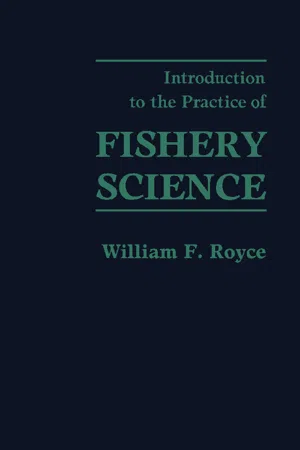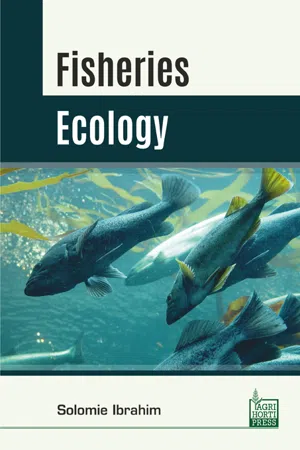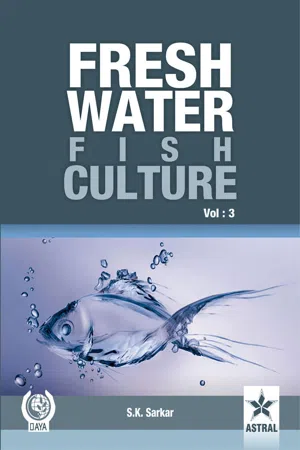Biological Sciences
Farming and Fishing
Farming and fishing are primary methods of obtaining food from the natural environment. Farming involves the cultivation of crops and the raising of livestock, while fishing involves the capture of aquatic organisms from rivers, lakes, and oceans. Both activities are essential for providing food and sustaining human populations, and they have significant impacts on ecosystems and the environment.
Written by Perlego with AI-assistance
Related key terms
1 of 5
6 Key excerpts on "Farming and Fishing"
- eBook - PDF
Fishery Products
Quality and Safety
- Anjanette S. Tadena(Author)
- 2019(Publication Date)
- Delve Publishing(Publisher)
Specific methods involve integrated multi-trophic aquaculture and aqua phonics, both of which collate aquatic plant farming and fish farming. Aquaculture is defined as farming of aquatic organisms such as crustaceans, mollusks, aquatic plants, and fishes. Aquaculture is also known as aquafarming, which is the farming of various aquatic organisms like aquatic plants, mollusks, crustaceans, and fish. This involves cultivation of saltwater populations and freshwater populations under stagnant conditions and events and may be opposed to the commercial fishing for trading, which involves harvesting of wild fishes. Introduction to Fisheries and Aquaculture 13 Fish is known to be an excellent source and basis of animal protein as well as a broad range of required nutrients. It significantly contributes to the security of the food. In the year 2008, many humans had an intake of nearly 80% of the fish production in the world that is almost 17.1-kilo grams per individual. The researchers have assumed that this consumption will increase to almost 20-kilo grams every year by 2030. The worldwide supply of fish products and fish reached almost 142.3 million tons of fish products and fish in the year 2008 that included a record of 52.5 million tons from the gradually emerging sector of aquaculture and a record of 10 million tons from the inland waters. If the aggregate production is to maintain the pace with an increasing global population. If the capture fisheries may remain stagnant, the subsequent growth can evolve from aquaculture. Indirectly or directly, aquaculture and fisheries play a significant role in the living standard of millions of individuals all over the world, starting from the inland fishers at small scale who harvest the fishes from river and lakes to the women and men who work in huge processing plants. - William F. Royce(Author)
- 2013(Publication Date)
- Academic Press(Publisher)
Part III Application of the Sciences Summary THE CAPTURE FISHERIES Commercial fishing is a business that supplies essential protein food and is an important economic activity in a majority of countries. Recreational fishing is also a widespread and economically important activity in most developed countries. Subsistence or small-scale commercial fishing is an occupation of perhaps nine million poor people who live near coastal and inland waters in many countries. Production from the world's fisheries tripled between 1950 and 1970 and ap-proached the maximum sustainable level for most of the conventional wild stocks. Fish prices are rising more rapidly than prices of other animal protein foods, thus stimulating more intensive fishing and improvements in methods of preservation and marketing, while also encouraging more social conflicts. Fishery scientists are increasingly involved in improving fishing methods, provid-ing general information services, and advising on investment strategy. THE CULTURE FISHERIES Leveling out of the production from capture fisheries is stimulating rapid increases in aquacultural production. 280 III. APPUCATION OF THE SCIENCES One major kind of aquaculture is fish farming of animals in ponds that are fertilized to produce all or a large part of their food. Many of these animals are om-nivorous. Fish farming is usually associated with field crops, poultry, or mam-malian production. A second major kind of aquaculture is pond, raceway, or cage culture in which the animals are fed a complete diet. Many of these animals are carnivorous. A third major kind of aquaculture is for filter-feeding mollusks in salt water. A fourth major kind of aquaculture is for attached aquatic plants. Culture of many diverse animals and plants is being attempted, including many for ornamental or bait use.- Gupta, V K(Authors)
- 2021(Publication Date)
- Daya Publishing House(Publisher)
However, Aquaculture is the cultivation of aquatic animals and plants, especially, fish shell fish and seaweed, in natural or controlled marine or freshwater environments. It is commonly known as ‘Fish Farming’ and since marine or freshwater animals and plants are grown on a commercial scale, it can be termed as ‘Commercial Underwater Agriculture’. There has been a continuous increase worldwide, in the demand for both fin-fish and shell-fish. As we know three-fourth of our planet’s surface is hydrosphere and 97 per cent of the hydrosphere is oceans. Now a days, increasing urbanization reduced the available land for agriculture and agriculture alone, is not sufficient to meet the requirement of protein rich, balanced diet for the population, which is growing at an alarming rate. This demographic flame is likely to consume this planet, unless, the problem of food production is efficiently tackled in time. So aqua farming can also be a vocation to generate employment and income in the rural sector and also in earning foreign exchange for the nation. Aquaculture has become one of the most lucrative of the farming practices (Agarwal, 2006). This ebook is exclusively for this university only. Cannot be resold/distributed. Aquaculture has already assumed the status of fast expanding industry, not only in India, but also, in several Asiatic countries over the recent past. Fisheries and aquaculture play a crucial role for food supply, food security and income generation. Million people work directly as fishers and fish farmers, with hundreds of millions more engaged in associated activities – the great majority in developing countries. Fish exports boost foreign currency earnings – particularly important in developing economies. In fact, aquatic foods are the most widely traded foodstuffs, outpacing agricultural products.- eBook - PDF
- Ibrahim, Solomie(Authors)
- 2018(Publication Date)
- Agri Horti Press(Publisher)
All these and other early variants of fish farming have been of the extensive type. Extensive fish farming implies that fish are not crowded much beyond their population density in nature and are not or almost not artificially fed. Thus, extensive fish farming hardly affects natural habitats. Environmental problems appeared only with intensification of the production. While the ancient fish farming was based on eggs/larvae/ juveniles collected from nature, in a true full circle aquaculture they should be produced on the farming premises. First to close the growth circle was a German farmer in the 18th century who fertilized trout eggs with their sperm and hatched them in tanks/ponds. During most of the 20th century, marine fisheries and fish farming were developing in parallel as This ebook is exclusively for this university only. Cannot be resold/distributed. Fisheries Farming System: Planning, Operations... 245 separate industries with little market interaction. By and large, each produced different species and had respective traditional consumers. But during recent decades, things have been changing on the fish market. Now many consumers buy fresh or smoked salmon, sea-bream, oysters, or frozen shrimp, many without knowing, and some without caring, whether they were caught in open sea by fishermen, or grown in ponds, mollusks farms, or floating cages. Presently, farming of some 15 species of marine finfish is in its starting phase or expanding, each according to the progress made by researchers and fish farmers. Notwithstanding, capture fisheries and fish farming are inter-related and to a great extent overlapping in their ecology, economics and social impacts. Both interact in several manners and often co-exist in common ecosystems. - eBook - PDF
- Jack A. Mathias, Charles Anthony(Authors)
- 2020(Publication Date)
- Taylor & Francis(Publisher)
The other two are culture-based fisheries—the enhancement of fish eries production in lakes, reservoirs and coastal marine habi tats— and the culture of filter-feeding mollusks in coastal marine areas. This paper will focus on freshwater aquaculture in ponds, lakes and reservoirs because that is where integrated fish farm ing has its greatest potential in the foreseeable future. It should be kept in mind, however, that the principles of integrated fish farming are equally applicable in certain marine habitats such as coastal shrimp ponds3 and protected coastal lagoons (Newkirk 1997; Brzeski and Newkirk 1997). 1 modified from Williams (1 995). 2 see Pullin, R.S.V., this volume, regarding environmental issues. 3 see Lee and Shang, this volume, for a theoretical analysis of this possibility. 1 -56670-260-7/97/$0.00+$.50 © 1997 by CRC Press LLC 4 Integrateci Fish Farming CONTRIBUTION OF INTEGRATED FISH FARMING TO GLOBAL FOOD SUPPLY Wild Fish Harvest The harvest of wild fish makes a significant contribution to the world supply of animal food. For the last three years that in formation is available, fisheries have been producing about 35 percent of the world’s animal protein. However, about a third of fish harvested by capture fisheries is not consumed directly by humans, but ends up as fish meal in various kinds of animal feeds. The contribution of fisheries to world food supply is more accurately measured as food available to humans (Table 1, row B). At about 28 percent of global animal-based food, that amounts to a global average of 13 kilograms of fish per person per year, compared to about 33 kilograms of animal food. While the contribution of fisheries to the world’s supply of animal-based food has been relatively stable at about 28 percent since 1989, the fisheries components have changed radically. The contribution of capture fisheries has declined while the con tribution of aquaculture has increased (Table 1). - eBook - PDF
- Sarkar, S K(Authors)
- 2021(Publication Date)
- Daya Publishing House(Publisher)
This task is elaborated in the 25th Chapter in post-culture technology series. And a very brief discussion on case study regarding trout and salmon marketing will complete the series. 22.1 General Considerations of Fish Harvesting The term harvesting encompasses all aspects of man’s occupation of the aquatic animal in the seas and in inland waters all over the world. A very wide variety of methods is employed. Men were huntered fish from different water bodies before they became agricultural farmers, and harvesting of fish This ebook is exclusively for this university only. Cannot be resold/distributed. from any water resource is, therefore, one of the oldest occupations of mankind. Increasing human populations have made the efficient harvesting of food from different water resources more and more important. Fish is a vital source of food in most countries of the world where the land is desolated, mountainous or inexorable and agriculture cannot be easily developed; and fish are intensively or extensively cultured and harvested on commercial basis and processed for the market. Moreover, modern aquaculture and fisheries are not only limited to harvest fish but also include many other harvests from inland and marine resources such as crabs, lobsters, clams, oysters, mussels, shrimps, prawns, cephalopods (cuttle fish, devil fish, squids), crayfish, and sea weeds. It must be presumed that different aquatic resources are exhaustible repository of fish and other aquatic animals. Indeed, there are vast areas of the inland waters which have very few fish. Many factors affect the productivity of freshwater resources. These include depth, siltation from surface flow-off, temperature variations, pollution, over-exploitation, and disposal of wastes. Consequently, expansion of many commercial fishing grounds are suffering from toxic and carcinogenic components present in a variety of agricultural chemicals.
Index pages curate the most relevant extracts from our library of academic textbooks. They’ve been created using an in-house natural language model (NLM), each adding context and meaning to key research topics.





